The Wood Stork is North America’s only breeding stork. This makes it all the more frightening that we came so close to losing these tall and elegant wading birds in the United States. As the Wood Stork’s U.S. population recovers, future generations will have the chance to celebrate this unusual and majestic resident of North America’s tropical and subtropical wetlands.
The Wood Stork used to be called the Wood Ibis, due to its resemblance to a large ibis. Though it’s a stork through and through, the bald head and face and black decurved bill of the Wood Stork is reminiscent of a large ibis.
Standing at up to four feet tall, the Wood Stork is a giant amongst even its fellow long-legged wading birds and its towering silhouette is a haunting symbol of the delicate beauty of the Everglades and the precious subtropical wetland habitats that pepper the U.S. South.
Related Article: Species Spotlight: The Wild Turkey
Fun Facts About the Wood Stork
The Wood Stork is an odd-looking bird. Its featherless neck and head are covered in scaly skin and its impressive height gives it a slightly formidable air. But there is more to this exceptional wading bird than its unusual looks. Let’s examine some Wood Stork fun facts!
Colony nesters: Wood Storks like a lot of company during the breeding season. They build large nests in trees, usually building them into forks in branches. They nest in dense colonies and a single tree may contain as many as 25 Wood Stork nests.
Water works: The tropical and subtropical regions where Wood Storks live can get pretty hot. Young Wood Stork chicks are altricial, meaning that they are born weak and helpless. They cannot regulate their own body temperature until they’ve grown a bit. This means that in cool weather they must be incubated even after hatching. In hot weather, Wood Stork parents swallow water and regurgitate it onto the nest, dousing their babies to help keep them cool.
Hostile takeover: Building a nest is a lot of work, so a completed nest in a good spot is a very valuable piece of real estate. Some Wood Storks try to take shortcuts by performing takeovers where they invade an unattended nest and remove the eggs or babies that might be inside in order to claim it as their own. These takeovers can occur when one parent is home, but in those cases the resident parents will often reclaim the nest together once the absent parent has returned.
Snap trap: Wood Storks hunt by dipping their bills in the water and holding them open. Thy may disturb the mud with their feet to stir up prey such as small fish or amphibians. With their bills open in the water, they wait until they feel something make contact with them and then snap that bill shut. Although their prey is mostly fish, they have been known to feed on baby alligators as well.
The Future of the Wood Stork
Globally, the Wood Stork is considered to be of “Least Concern” when it comes to conservation. This is in spite of the fact that Wood Stork populations are dropping. The Wood Stork remains listed as “Least Concern” thanks to its enormous habitat range.
In some parts of that range, though, the Wood Stork was very nearly lost. Due to excessive development of wetland habitats in the 1970s, the United States population of the Wood Stork dropped to about a quarter of its previous size by 1984. This sharp decline led these birds to be classified as endangered in the United States. In 2014 conservation successes inspired the Wood Stork to be downgraded from “endangered” to “threatened.” Recent proposals have even suggested that it is time to delist the Wood Stork from the Endangered Species Act, now that its recovery has come so far.
This is all very good news, but it’s important to temper our excitement. Despite conservation successes in the United States, global Wood Stork populations continue to sink.
Popular Article: Study Indicates That Roosters May Be Self-Aware

